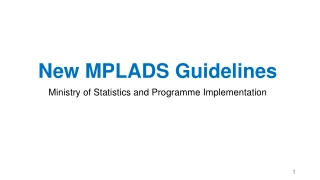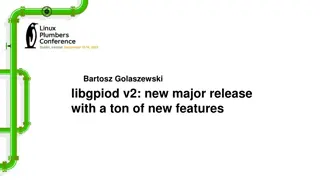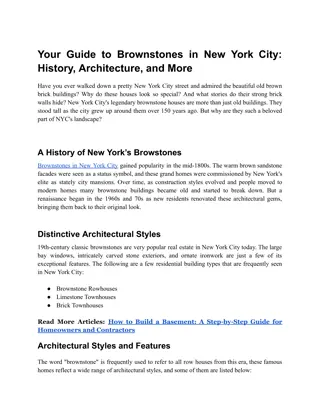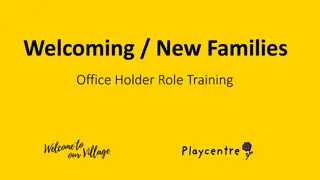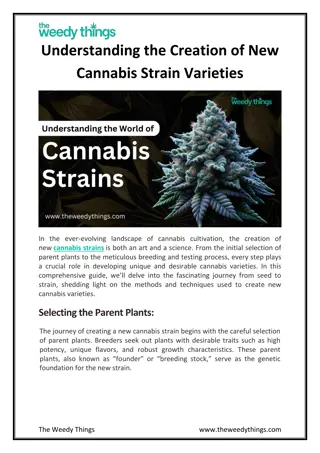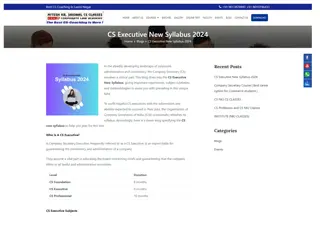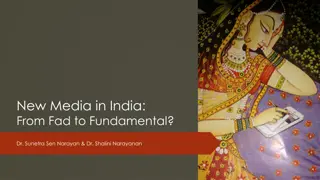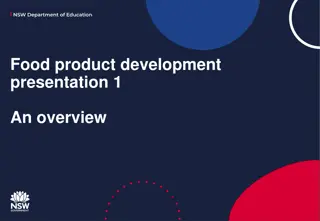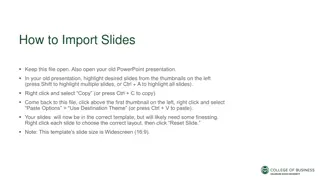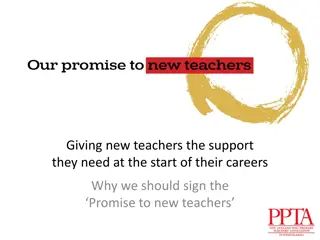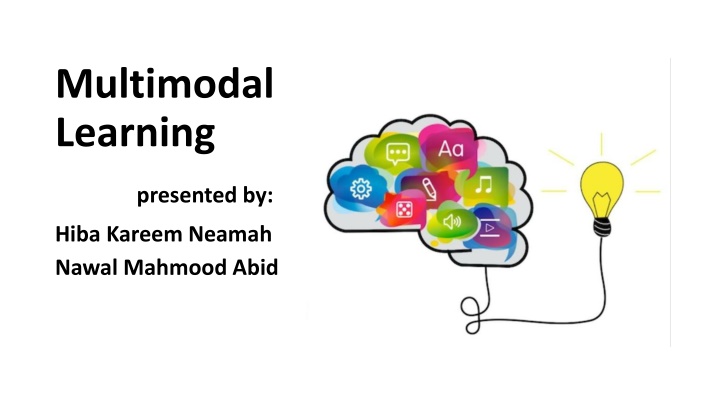
Understanding Multimodal Learning in Education
Explore the concept of multimodal learning, which involves utilizing diverse sensory and communicative modes to enhance learning experiences. Learn how multimodal learning strategies, such as visual, auditory, and kinesthetic methods, can benefit learners in educational settings. Discover the importance of engaging multiple senses and modes to create a dynamic learning environment that caters to various learning styles.
Download Presentation

Please find below an Image/Link to download the presentation.
The content on the website is provided AS IS for your information and personal use only. It may not be sold, licensed, or shared on other websites without obtaining consent from the author. If you encounter any issues during the download, it is possible that the publisher has removed the file from their server.
You are allowed to download the files provided on this website for personal or commercial use, subject to the condition that they are used lawfully. All files are the property of their respective owners.
The content on the website is provided AS IS for your information and personal use only. It may not be sold, licensed, or shared on other websites without obtaining consent from the author.
E N D
Presentation Transcript
Multimodal Learning presented by: Hiba Kareem Neamah Nawal Mahmood Abid
What is multimodality? Multimodality is a term that was first coined in the 1990s and is used in the academic world where it tackles such disciplines as semiotics, linguistics, media studies, education, and other sciences. Multimodality can be referred to as making meaning in a variety of ways or communicating in different ways. Bateman (2017, p. 2) defines it as "a way of characterizing communicative situations that relies upon a combination of different forms of communication to be effective. For example, the TV program uses spoken language, pictures, and texts; the book uses written language and diagrams; and the learning process may include the use of different educational techniques.
Multimodal Learning Multimodal Learning Multimodal learning is the teaching of a concept using more than one mode. By engaging the mind in multiple learning styles at the same time, learners experience a diverse learning style that collectively suits all of them. According to Jewett (2014, p. 4), the term "mode" is identified as a "sign system," "sign repertoire," or "semiotic system" to be used by communicators to express their communicative intention. Accordingly, multimodality means a combination of multiple sensory and communicative modes, such as; images, videos, sight, music, and so on. The multimodal learning process is based on the concept that teachers' courses are supposed to embrace different learning formats and ways to learn in order to increase learners' engagement with the learning environment, and it is a helpful methodology to memorize when creating learning content..
Multimodal Learning Multimodal Learning Strategies Strategies Caroline (2012, p. 12) suggests that when a number of our senses visual, auditory, and kinesthetic are being engaged during learning, we understand and remember more. By combining these modes, learners experience learning in a variety of ways to create a diverse learning style. There are four main methods of multimodal learning: visual, auditory, reading and writing, and kinesthetic (VARK). VARK is a valuable model to keep top-of-mind when trying to create diverse learning content to engage learners.
Methods of Learning Methods of Learning Visual Learning: This method of learning involves the use of graphs, infographics, cartoons, illustrations, videos, artwork, and diagrams anything that primarily stimulates the learner s eyes. Techniques like colour coding information, using different fonts, and labelling important points with stickers are all part of the learning process. Auditory Learning: This method is mostly concerned with what we listen to. This can be in the form of a webinar, an audiobook, or an instructor talking to learners face-to-face.
Multimodal Learning Multimodal Learning Strategies Strategies Writing and reading are the types of learning we are all familiar with. Here, you'll find text-based courses, PDFs, documents, and books. Additionally, most written exams or assignments, like true-false or multiple-choice questions, fall under this bracket too. Kinesthetic Learning: It gets learners active; it can involve site visits, demonstrations, and multimedia presentations. This method is a combination of several types of learning; for example, making videos combines visual, auditory, and kinesthetic skills. Teachers help learners learn by using different teaching methods and providing opportunities for physical activity. These methods of learning interact with each other to achieve learning goals. .
How to create a How to create a multimodal approach multimodal approach to Learning. to Learning. 1- The first step with multimodal learning is to simply dive in and plan how you can add more modes to your courses. When you re creating your course, think outside the box and start to use different formats, like video, slides, and audio. . taking advantage of resources outside of your organization, like YouTube videos and podcasts on the subject of focus. From here, you can then start creating your own video, slides, audio, and interactive learning sessions. Learners can support a wide range of content formats, including Word, PowerPoint, PDF, video, and audio.
Blended Learning Blended Learning 2- You can use blended learning techniques, which mean combining face-to-face training with online instructions through someone s multimodal learning strategy. With blended learning, you can hold a live training session with a group of learners, post some extra resources for them, and assign a task or exam to ensure they understand the topic completely. As an example of blended learning, someone could take an online course to learn the basics of a topic but then attend an in person seminar to directly engage with experts and up their skills.
How can you create a multimodal How can you create a multimodal approach to learning. approach to learning. 3- Learners can do multimodal assignments. If you are training through multimodal learning, you can get benefit from a variety of different means of assessment. As part of their assignments, learners can create their own videos, and audio projects. Setting multimodal assignments lets learners get creative and encourages them to use different parts of their brain. According to cognitive learning theory, when learners are actively involved in their own learning, they retain more of their learning, so multimodal assignments are likely to create better results.
How can you create a How can you create a multimodal approach to multimodal approach to learning. learning. 4- Providing feedback through different media. It s possible for the instructors to give their group of students feedback in person. If the students work remotely or offsite, or if you want to provide information to a large group and don t have the capacity to speak to everyone individually, recording a short video and posting it can be a great solution. With the teacher's videos, learners can hear the teacher s encouraging tone of voice and their relaxed body language, and they will understand the teachers feedback is constructive and well meant.
Benefits of Multimodal Learning Students learn best when educators appeal to different learning styles at the same time, which is possible through multimodal learning. Multimodal learning engages the brain in multiple learning styles at the same time through the use of various media. For example, a video lesson with subtitles and a downloadable information sheet leverages visual, auditory, and written learning styles. Furthermore, a multimodal learning strategy is more effective than using only one learning style for knowledge acquisition. Lazear (2018) values a multimodal learning strategy when he says: "The more different ways you learn something, the more you will learn it"
Benefits of Multimodalities 1- All students are involved in the learning process: Teaching with one mode risks alienating students who cannot fully comprehend the content of the chosen method. With multimodal learning, every student is guaranteed to have at least two of her preferences met at some point during the lesson. 2- Improves learning quality: regardless of how many or which learning styles students prefer, multiple modes of communication improve content retention. 3- People rarely experience the world in one dimension; instead, they are immersed in pictures, videos, words, and movements. Such learning mirrors students experiences inside and outside the classroom.
4- Develops students skills in all modes: this strategy introduces students to all modalities, which prepares them for the real-life challenges they will face as they venture beyond the walls of the classroom into universities, relationships, and careers. 5- Increases teachers' and students' creativity: teachers rely on the best resources to supplement their lessons. Some teachers even go so far as to create media themselves. Likewise, students get to demonstrate their knowledge through thought-provoking projects that challenge them to approach problems in new ways and highlight their unique abilities.
6- Maintains novelty in the classroom. Students need variety. Without it, learning becomes predictable and causes them to disengage from the content. Multimodal learning makes every lesson feel new and exciting because it offers increased sensory stimulation and frequent transitions. 7- Inspires cooperative learning. When teachers focus on content delivery and assessment on individual content, every student has the opportunity to become an expert in that content in a unique way. Alowing students to present concepts according to their learning style. Multimodal learning affords the students the chance to reinforce their learning and gain perspective through peer interactions.
Teachers intend to activate different ways of meaning-making, and learners tend to reinforce certain knowledge by using the multiple modes within their preferences. The multiple modes used by teachers and learners are considered "activated signs" through which it is easier to learn and improve attention. Mayer (2003) contends that students learn more deeply from a combination of words, pictures, and images than from words alone. This is called the "multimedia effect" for its different ways of meaning-making.

